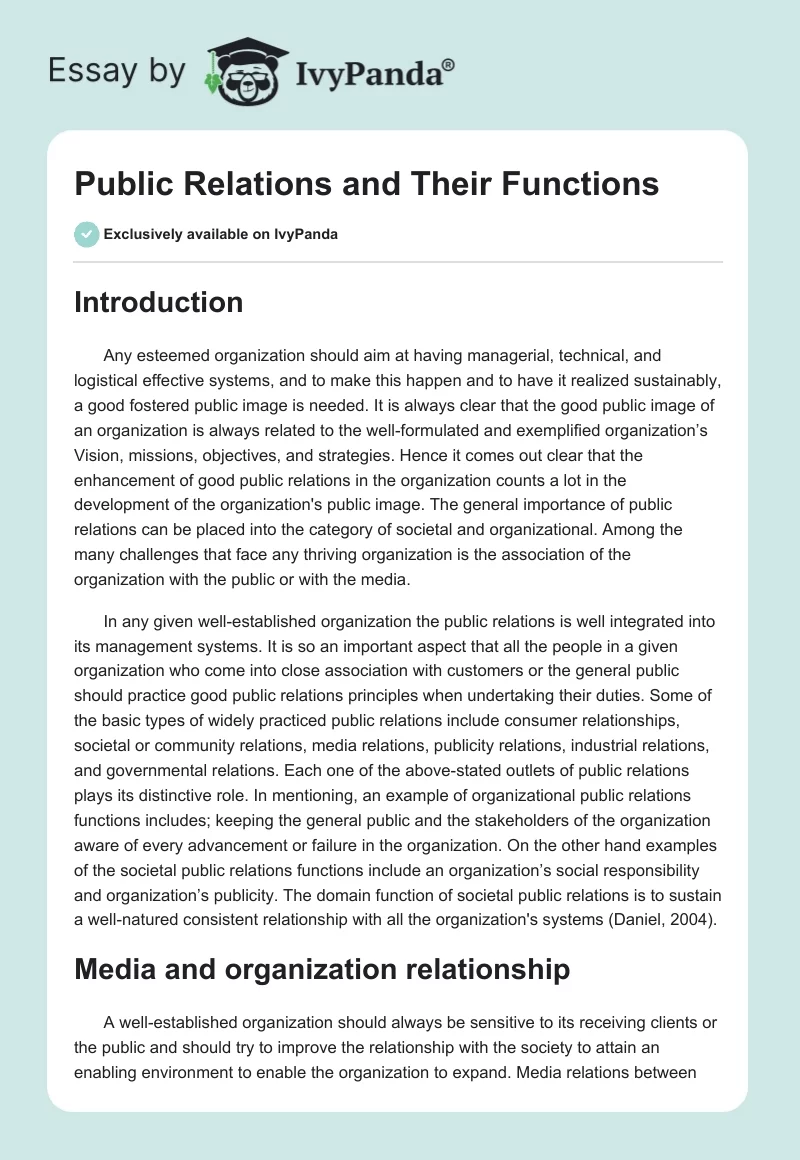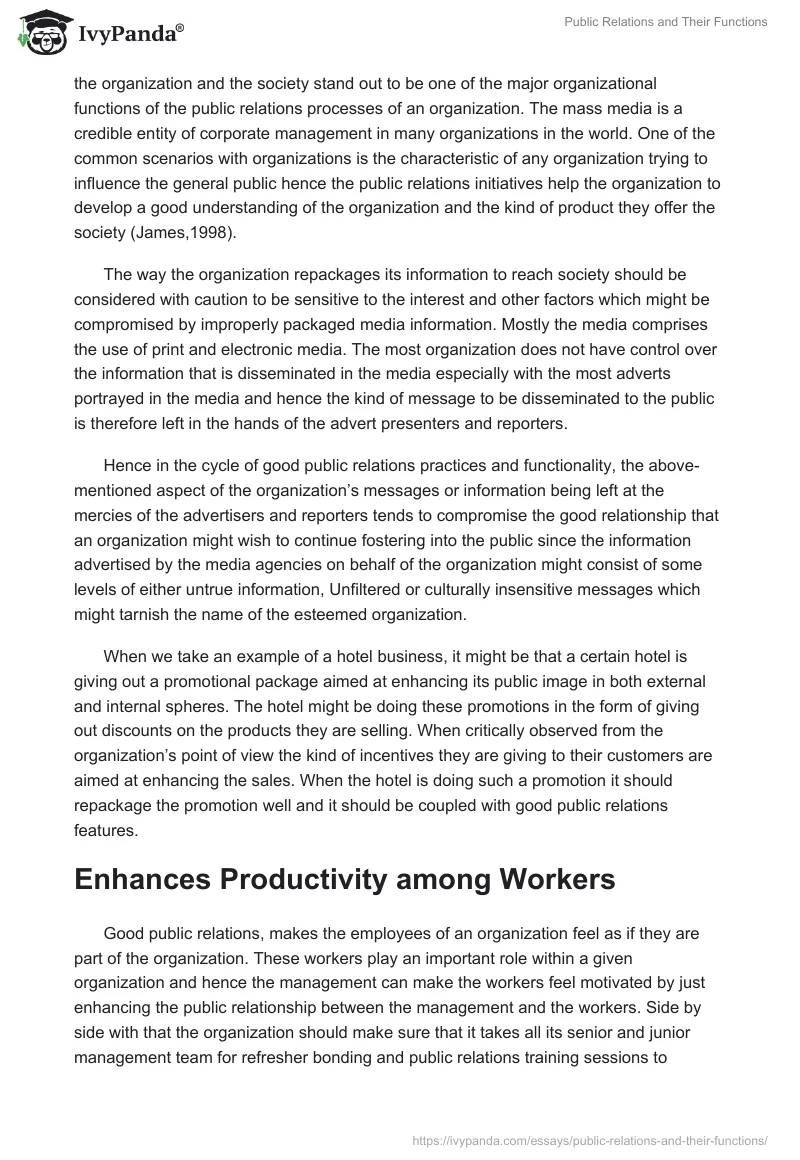Introduction
Any esteemed organization should aim at having managerial, technical, and logistical effective systems, and to make this happen and to have it realized sustainably, a good fostered public image is needed. It is always clear that the good public image of an organization is always related to the well-formulated and exemplified organization’s Vision, missions, objectives, and strategies. Hence it comes out clear that the enhancement of good public relations in the organization counts a lot in the development of the organization’s public image. The general importance of public relations can be placed into the category of societal and organizational. Among the many challenges that face any thriving organization is the association of the organization with the public or with the media.
In any given well-established organization the public relations is well integrated into its management systems. It is so an important aspect that all the people in a given organization who come into close association with customers or the general public should practice good public relations principles when undertaking their duties. Some of the basic types of widely practiced public relations include consumer relationships, societal or community relations, media relations, publicity relations, industrial relations, and governmental relations. Each one of the above-stated outlets of public relations plays its distinctive role. In mentioning, an example of organizational public relations functions includes; keeping the general public and the stakeholders of the organization aware of every advancement or failure in the organization. On the other hand examples of the societal public relations functions include an organization’s social responsibility and organization’s publicity. The domain function of societal public relations is to sustain a well-natured consistent relationship with all the organization’s systems (Daniel, 2004).
Media and organization relationship
A well-established organization should always be sensitive to its receiving clients or the public and should try to improve the relationship with the society to attain an enabling environment to enable the organization to expand. Media relations between the organization and the society stand out to be one of the major organizational functions of the public relations processes of an organization. The mass media is a credible entity of corporate management in many organizations in the world. One of the common scenarios with organizations is the characteristic of any organization trying to influence the general public hence the public relations initiatives help the organization to develop a good understanding of the organization and the kind of product they offer the society (James,1998).
The way the organization repackages its information to reach society should be considered with caution to be sensitive to the interest and other factors which might be compromised by improperly packaged media information. Mostly the media comprises the use of print and electronic media. The most organization does not have control over the information that is disseminated in the media especially with the most adverts portrayed in the media and hence the kind of message to be disseminated to the public is therefore left in the hands of the advert presenters and reporters.
Hence in the cycle of good public relations practices and functionality, the above-mentioned aspect of the organization’s messages or information being left at the mercies of the advertisers and reporters tends to compromise the good relationship that an organization might wish to continue fostering into the public since the information advertised by the media agencies on behalf of the organization might consist of some levels of either untrue information, Unfiltered or culturally insensitive messages which might tarnish the name of the esteemed organization.
When we take an example of a hotel business, it might be that a certain hotel is giving out a promotional package aimed at enhancing its public image in both external and internal spheres. The hotel might be doing these promotions in the form of giving out discounts on the products they are selling. When critically observed from the organization’s point of view the kind of incentives they are giving to their customers are aimed at enhancing the sales. When the hotel is doing such a promotion it should repackage the promotion well and it should be coupled with good public relations features.
Enhances Productivity among Workers
Good public relations, makes the employees of an organization feel as if they are part of the organization. These workers play an important role within a given organization and hence the management can make the workers feel motivated by just enhancing the public relationship between the management and the workers. Side by side with that the organization should make sure that it takes all its senior and junior management team for refresher bonding and public relations training sessions to sustain the management to staff relationship in the organization. It has been observed that if the management practices good public relations with its staff the staff will be productive and also extend good public relations to the public on behalf of the organization. Organizations can then easily organize fully staff team participatory events without the doubt of the bad outcome. A worker’s relation is very important in that it helps organizations to sustain a lively line of communication to make its workers interested in new ideas and to share the vision and mission of the organization equally with the management.
Enhancement of Social Responsibility
Good public relations practices and Social responsibilities account for some of the flourishing transition of collective expectations and depend mostly on how the organization addresses and responds to moral conduct. The enhancement of an organization’s social responsibility strictly has more to do with how well that particular organization relates to the beneficiaries or the public. Hence the way an organization conducts itself in its immediate surroundings will work towards its acceptability or bad reception by the general public. Hence the kind of relationships a given organization displays to its surroundings is a clear determining factor of the organization’s ethical procedures (Harris, 1998).
Resolving Some of the Organizational Malpractices of Public Relations
Apart from the already mentioned above the need of every visionary organization involving all its staff and management in public relations training forums and refresher courses the organization should instill working ethics and proper standards without compromising on the welfare of the workers and the receptive society. Management ethics are the key elements in an organization’s governance and coordination. It is also important that every organization or company make informed public relations and ethical policies and direct the workers to follow and abide by them.
Conclusion
Public relations principles are very important and applicable in a vast array of activities that have both direct and indirect impacts on the organization on different levels. Numerous details could be mention above exhaustively but they rotate around the already mentioned facets of societal or organizational public relations functions. All the organizational and societal public relations function seems to interrelate well between each other in a properly functioning organization. In all the cases when a given organization needs to share out information or messages to either its employees or the general public the organizational and societal public relations functionality will come into play and they will influence the way that given information is disseminated. Hence the organizational and societal public relations functions overlap each other significantly.
References
Harris, B. (1998) Enhancing effective organizational interrelationship culture, Macmillan Publishers.
Daniel, A. (2004) Importance of a good public relations: Building a growing Organization, McGraw Hill Press.
James, B. (1998). Factoring Organizational Public Relations in Management, Management Press.


